Malek Mouhoub
On-policy Actor-Critic Reinforcement Learning for Multi-UAV Exploration
Sep 17, 2024



Abstract:Unmanned aerial vehicles (UAVs) have become increasingly popular in various fields, including precision agriculture, search and rescue, and remote sensing. However, exploring unknown environments remains a significant challenge. This study aims to address this challenge by utilizing on-policy Reinforcement Learning (RL) with Proximal Policy Optimization (PPO) to explore the {two dimensional} area of interest with multiple UAVs. The UAVs will avoid collision with obstacles and each other and do the exploration in a distributed manner. The proposed solution includes actor-critic networks using deep convolutional neural networks {(CNN)} and long short-term memory (LSTM) for identifying the UAVs and areas that have already been covered. Compared to other RL techniques, such as policy gradient (PG) and asynchronous advantage actor-critic (A3C), the simulation results demonstrate the superiority of the proposed PPO approach. Also, the results show that combining LSTM with CNN in critic can improve exploration. Since the proposed exploration has to work in unknown environments, the results showed that the proposed setup can complete the coverage when we have new maps that differ from the trained maps. Finally, we showed how tuning hyper parameters may affect the overall performance.
Machine Learning and Constraint Programming for Efficient Healthcare Scheduling
Sep 11, 2024



Abstract:Solving combinatorial optimization problems involve satisfying a set of hard constraints while optimizing some objectives. In this context, exact or approximate methods can be used. While exact methods guarantee the optimal solution, they often come with an exponential running time as opposed to approximate methods that trade the solutions quality for a better running time. In this context, we tackle the Nurse Scheduling Problem (NSP). The NSP consist in assigning nurses to daily shifts within a planning horizon such that workload constraints are satisfied while hospitals costs and nurses preferences are optimized. To solve the NSP, we propose implicit and explicit approaches. In the implicit solving approach, we rely on Machine Learning methods using historical data to learn and generate new solutions through the constraints and objectives that may be embedded in the learned patterns. To quantify the quality of using our implicit approach in capturing the embedded constraints and objectives, we rely on the Frobenius Norm, a quality measure used to compute the average error between the generated solutions and historical data. To compensate for the uncertainty related to the implicit approach given that the constraints and objectives may not be concretely visible in the produced solutions, we propose an alternative explicit approach where we first model the NSP using the Constraint Satisfaction Problem (CSP) framework. Then we develop Stochastic Local Search methods and a new Branch and Bound algorithm enhanced with constraint propagation techniques and variables/values ordering heuristics. Since our implicit approach may not guarantee the feasibility or optimality of the generated solution, we propose a data-driven approach to passively learn the NSP as a constraint network. The learned constraint network, formulated as a CSP, will then be solved using the methods we listed earlier.
Constrained Optimization with Qualitative Preferences
Sep 24, 2021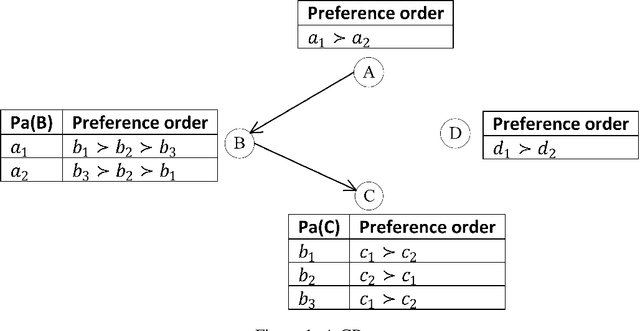
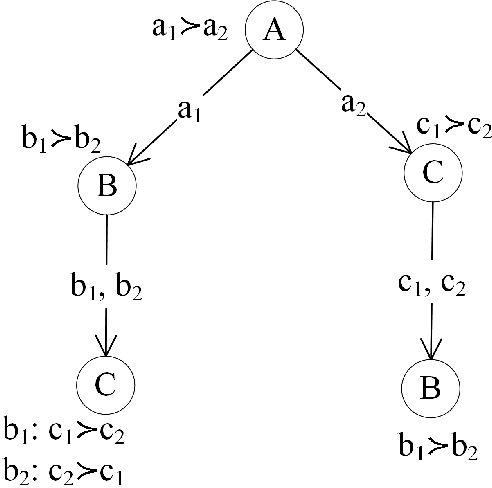
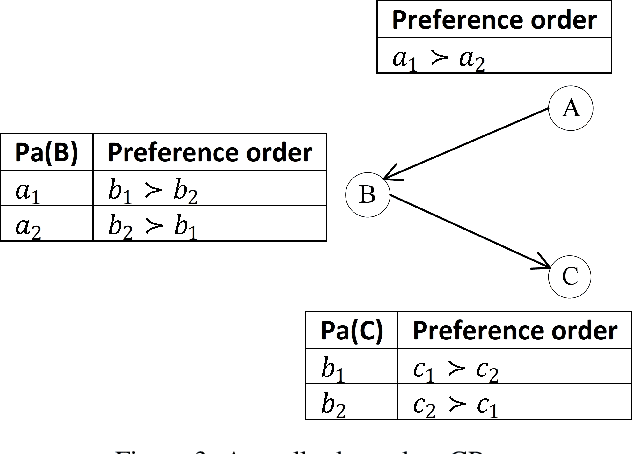
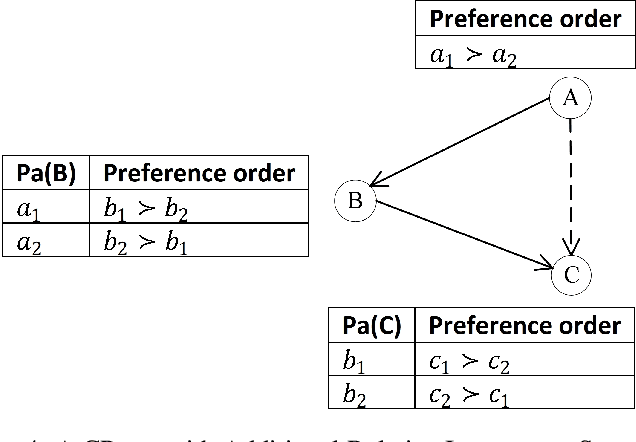
Abstract:The Conditional Preference Network (CP-net) graphically represents user's qualitative and conditional preference statements under the ceteris paribus interpretation. The constrained CP-net is an extension of the CP-net, to a set of constraints. The existing algorithms for solving the constrained CP-net require the expensive dominance testing operation. We propose three approaches to tackle this challenge. In our first solution, we alter the constrained CP-net by eliciting additional relative importance statements between variables, in order to have a total order over the outcomes. We call this new model, the constrained Relative Importance Network (constrained CPR-net). Consequently, We show that the Constrained CPR-net has one single optimal outcome (assuming the constrained CPR-net is consistent) that we can obtain without dominance testing. In our second solution, we extend the Lexicographic Preference Tree (LP-tree) to a set of constraints. Then, we propose a recursive backtrack search algorithm, that we call Search-LP, to find the most preferable outcome. We prove that the first feasible outcome returned by Search-LP (without dominance testing) is also preferable to any other feasible outcome. Finally, in our third solution, we preserve the semantics of the CP-net and propose a divide and conquer algorithm that compares outcomes according to dominance testing.
Exact Learning of Qualitative Constraint Networks from Membership Queries
Sep 23, 2021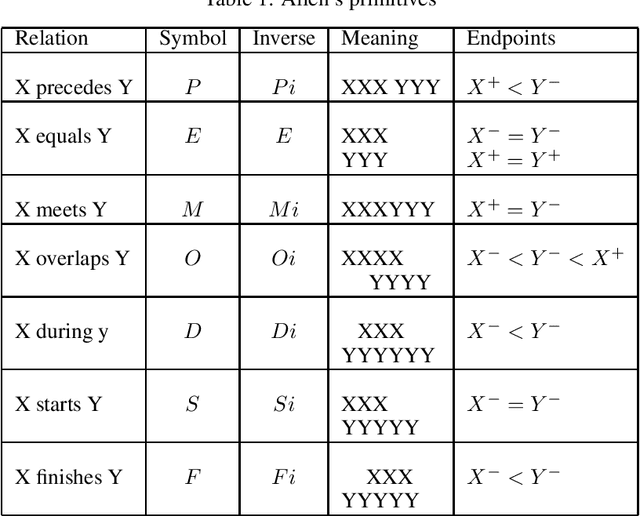


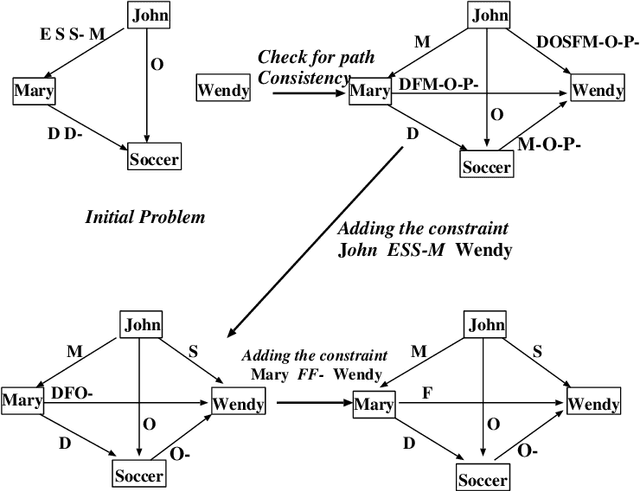
Abstract:A Qualitative Constraint Network (QCN) is a constraint graph for representing problems under qualitative temporal and spatial relations, among others. More formally, a QCN includes a set of entities, and a list of qualitative constraints defining the possible scenarios between these entities. These latter constraints are expressed as disjunctions of binary relations capturing the (incomplete) knowledge between the involved entities. QCNs are very effective in representing a wide variety of real-world applications, including scheduling and planning, configuration and Geographic Information Systems (GIS). It is however challenging to elicit, from the user, the QCN representing a given problem. To overcome this difficulty in practice, we propose a new algorithm for learning, through membership queries, a QCN from a non expert. In this paper, membership queries are asked in order to elicit temporal or spatial relationships between pairs of temporal or spatial entities. In order to improve the time performance of our learning algorithm in practice, constraint propagation, through transitive closure, as well as ordering heuristics, are enforced. The goal here is to reduce the number of membership queries needed to reach the target QCN. In order to assess the practical effect of constraint propagation and ordering heuristics, we conducted several experiments on randomly generated temporal and spatial constraint network instances. The results of the experiments are very encouraging and promising.
An Ontology-Based Information Extraction System for Residential Land Use Suitability Analysis
Sep 16, 2021



Abstract:We propose an Ontology-Based Information Extraction (OBIE) system to automate the extraction of the criteria and values applied in Land Use Suitability Analysis (LUSA) from bylaw and regulation documents related to the geographic area of interest. The results obtained by our proposed LUSA OBIE system (land use suitability criteria and their values) are presented as an ontology populated with instances of the extracted criteria and property values. This latter output ontology is incorporated into a Multi-Criteria Decision Making (MCDM) model applied for constructing suitability maps for different kinds of land uses. The resulting maps may be the final desired product or can be incorporated into the cellular automata urban modeling and simulation for predicting future urban growth. A case study has been conducted where the output from LUSA OBIE is applied to help produce a suitability map for the City of Regina, Saskatchewan, to assist in the identification of suitable areas for residential development. A set of Saskatchewan bylaw and regulation documents were downloaded and input to the LUSA OBIE system. We accessed the extracted information using both the populated LUSA ontology and the set of annotated documents. In this regard, the LUSA OBIE system was effective in producing a final suitability map.
Optimizing Neural Network Weights using Nature-Inspired Algorithms
May 20, 2021



Abstract:This study aims to optimize Deep Feedforward Neural Networks (DFNNs) training using nature-inspired optimization algorithms, such as PSO, MTO, and its variant called MTOCL. We show how these algorithms efficiently update the weights of DFNNs when learning from data. We evaluate the performance of DFNN fused with optimization algorithms using three Wisconsin breast cancer datasets, Original, Diagnostic, and Prognosis, under different experimental scenarios. The empirical analysis demonstrates that MTOCL is the most performing in most scenarios across the three datasets. Also, MTOCL is comparable to past weight optimization algorithms for the original dataset, and superior for the other datasets, especially for the challenging Prognostic dataset.
Effect of Word Embedding Models on Hate and Offensive Speech Detection
Nov 23, 2020



Abstract:Deep neural networks have been adopted successfully in hate speech detection problems. Nevertheless, the effect of the word embedding models on the neural network's performance has not been appropriately examined in the literature. In our study, through different detection tasks, 2-class, 3-class, and 6-class classification, we investigate the impact of both word embedding models and neural network architectures on the predictive accuracy. Our focus is on the Arabic language. We first train several word embedding models on a large-scale unlabelled Arabic text corpus. Next, based on a dataset of Arabic hate and offensive speech, for each detection task, we train several neural network classifiers using the pre-trained word embedding models. This task yields a large number of various learned models, which allows conducting an exhaustive comparison. The empirical analysis demonstrates, on the one hand, the superiority of the skip-gram models and, on the other hand, the superiority of the CNN network across the three detection tasks.
The Complexity of Learning Acyclic Conditional Preference Networks
Aug 25, 2018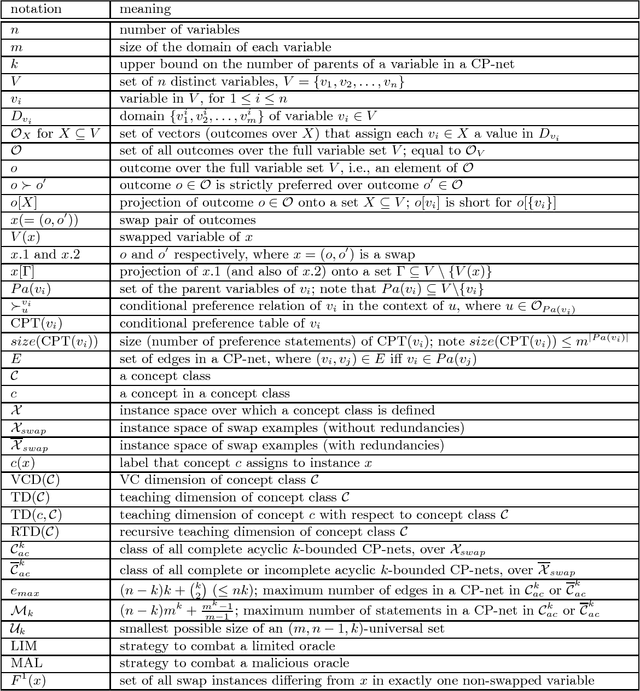



Abstract:Learning of user preferences, as represented by, for example, Conditional Preference Networks (CP-nets), has become a core issue in AI research. Recent studies investigate learning of CP-nets from randomly chosen examples or from membership and equivalence queries. To assess the optimality of learning algorithms as well as to better understand the combinatorial structure of classes of CP-nets, it is helpful to calculate certain learning-theoretic information complexity parameters. This article focuses on the frequently studied case of learning from so-called swap examples, which express preferences among objects that differ in only one attribute. It presents bounds on or exact values of some well-studied information complexity parameters, namely the VC dimension, the teaching dimension, and the recursive teaching dimension, for classes of acyclic CP-nets. We further provide algorithms that learn tree-structured and general acyclic CP-nets from membership queries. Using our results on complexity parameters, we assess the optimality of our algorithms as well as that of another query learning algorithm for acyclic CP-nets presented in the literature. Our algorithms are near-optimal, and can, under certain assumptions, be adapted to the case when the membership oracle is faulty.
 Add to Chrome
Add to Chrome Add to Firefox
Add to Firefox Add to Edge
Add to Edge